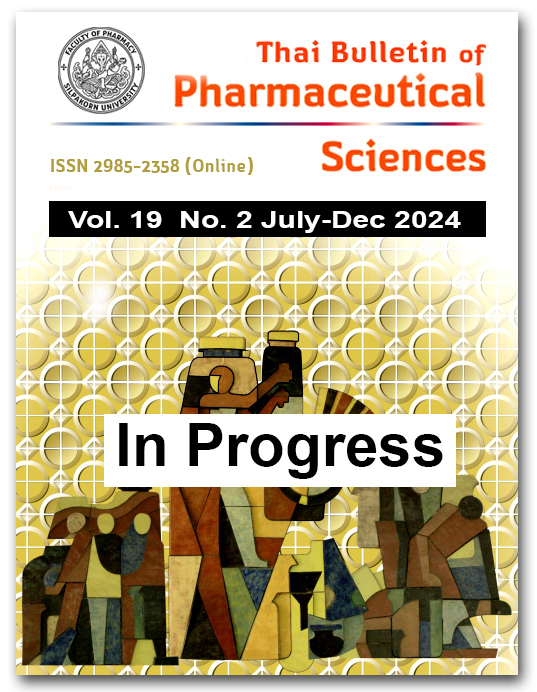DETERMINATION OF EXTRACTIVE VALUES BY UV/VIS SPECTROPHOTOMETRY COUPLED WITH CHEMOMETRIC METHODS: CASE STUDIES OF TURMERIC, ANDROGRAPHIS AND ROSELLE
DOI:
https://doi.org/10.69598/tbps.19.2.185-194Keywords:
extractive value, chemometric, UV/Vis spectrophotometryAbstract
An extractive value is a quality control parameter of herbal raw materials. Its determination process requires patience and consumes a lot of electrical energy. This study explored the correlation between the extractive values and UV/Vis spectral data. The spectroscopic data was analyzed using partial-least square regression and multiple linear regression to estimate the extractive values. Turmeric, andrographis, and roselle were selected as case studies due to the diverse polarities exhibited by their chemical components. The predictive models for the ethanol-soluble extractives of all herbs, as well as the water-soluble extractives of andrographis and roselle, were effectively developed. Nevertheless, the model for the water extractive of turmeric did not yield successful results. The effectiveness of the chemometric approach relied on the chemical composition of the individual herbs. The reliability of the developed models was assessed by the acceptable root mean square error of cross-validation and root mean square error of prediction. The accuracy of each model was greater than 94%. This study presented an innovative concept that had the potential applicability to other herbs.
References
Thai Pharmacopoeia Committee. Thai Herbal Pharmacopoeia [Internet]. 2024 [cited 2024 March 15]. Available from: https://bdn.go.th/thp/home
World Health Organization. Quality control methods for medicinal plant materials [Internet]. 1998 [cited 2024 March 15]. Available from: https://www.who.int/docs/default-source/medicines/norms-and-standards/guidelines/quality-control/quality-control-methods-for-medicinal-plant-materials.pdf?sfvrsn=b451e7c6_0
Sharma R, Amin H, Shukla VJ, Kartar D, Galib R, Prajapati PK. Quality control evaluation of Guduchi Satva (solid aqueous extract of Tinospora cordifolia (Willd.) Miers): An herbal formulation. Int J Green Pharm. 2013;7(3):258–63.
Hartanti D, Theeravit J. Quality control of crude drugs and capsules of turmeric (Curcuma longa L.). Pharm J Indones. 2018;15(2):257-66.
Pannu A, Goyal RK. Pharmacognostical characterization of whole Scutellaria barbata herb for quality control assessment. Innov Int J Med Pharm Sci. 2021; 6(4):1-5.
Zambare AV, Chakraborthy GS, Banerjee SK. Pharmacognostic studies of potential herb - Tridax procumbens Linn. IJPSR. 2010;1(9):58–62.
Chandel HS, Pathak AK, Tailang M. Standardization of some herbal antidiabetic drugs in polyherbal formulation. Pharmacognosy Res. 2011;3(1):49-56.
Brereton RG. Chemometric: Data analysis for the laboratory and chemical plant. Chichester: John Wiley & Sons; 2003.
Fuloria S, Mehta J, Chandel A, Sekar M, Rani NNIM, Begum MY, et al. A comprehensive review on the therapeutic potential of Curcuma longa Linn. in relation to its major active constituent curcumin. Front Pharmacol. 2022;13:820806.
Subramanian R, Asmawi MZ, Sadikun A. A bitter plant with a sweet future? A comprehensive review of an oriental medicinal plant: Andrographis paniculata. Phytochem Rev. 2012;11:39–75.
Ashenafi EL, Nyman MC, Shelley JT, Mattson NS. Spectral properties and stability of selected carotenoid and chlorophyll compounds in different solvent systems. Food Chem Adv. 2023;2:100178.
Da-Costa-Rocha I, Bonnlaender B, Sievers H, Pischel I, Heinrich M. Hibiscus sabdariffa L. – A phytochemical and pharmacological review. Food Chem. 2014;165:424–43.
Tanaka K, Kuba Y, Sasaki T, Hiwatashi F, Komatsu K. Quantitation of curcuminoids in curcuma rhizome by near-infrared spectroscopic analysis. J Agric Food Chem. 2008;56(19):8787–92.
Downloads
Published
How to Cite
Issue
Section
License
All articles published and information contained in this journal such as text, graphics, logos and images is copyrighted by and proprietary to the Thai Bulletin of Pharmaceutical Sciences, and may not be reproduced in whole or in part by persons, organizations, or corporations other than the Thai Bulletin of Pharmaceutical Sciences and the authors without prior written permission.



